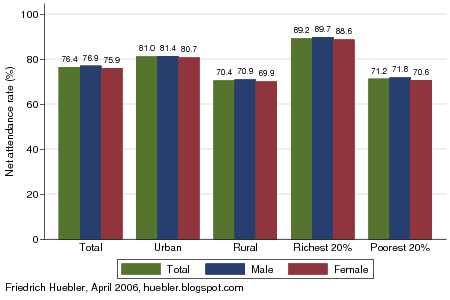UNESCO has released the 2006 edition of its annual Global Education Digest, with data for 2004 or the latest year available. The focus of this year's edition is tertiary education. The 2006 Global Education Digest can be downloaded in PDF format from the website of the UNESCO Institute for Statistics (UIS). The UIS also provides the statistical tables from the report in Excel format. I will use the data to update my global overview of primary and secondary school enrollment and other statistics on this site.
Friedrich Huebler, 26 April 2006, Creative Commons License
26 April 2006
16 April 2006
Primary school attendance in Bolivia
Bolivia, one of the poorest nations in Latin American, is the only country from that region among UNICEF's 25 priority countries for girls' education. In 2005, the population of Bolivia was estimated at 9.1 million, including 1.4 million children of primary school age (6 to 11 years).
A Demographic and Health Survey (DHS) was carried out in Bolivia in 2003/04. This nationally representative household survey collected data in various areas, including education. According to the survey results, the primary school net attendance rate (NAR) is 76.4 percent. The primary school NAR is the share of children of primary school age that are attending primary school. In Bolivia, one in four children of primary school age are thus not in primary school according to the DHS.
Bolivia is not close to the Millennium Development Goal (MDG) of universal primary education, but the goal of gender parity has been reached. With 75.9 percent, the primary school NAR of girls is almost the same as that of boys, 76.9 percent. The gender parity index (GPI), the ratio of female to male NAR, is 0.99. The NAR values are shown in the graph and table below.
Primary school net attendance rate, Bolivia 2003/04

Data source: Bolivia 2003/04 DHS.
There is no gender disparity in Bolivia but disparities exist at other levels. Children in urban areas have a higher primary school NAR (81.0 percent) than children in rural areas (70.4 percent). Household wealth is strongly associated with school attendance. In the richest 20 percent of all households, 89.2 percent of all children of primary school age attend primary school. In the poorest 20 percent of all households, the primary school NAR is 71.2 percent. Raising attendance rates among the rural population and among the poor remains a challenge in Bolivia.
Primary school net attendance rate, Bolivia 2003/04
GPI: gender parity index. - Data source: Bolivia 2003/04 DHS.
Related articles
A Demographic and Health Survey (DHS) was carried out in Bolivia in 2003/04. This nationally representative household survey collected data in various areas, including education. According to the survey results, the primary school net attendance rate (NAR) is 76.4 percent. The primary school NAR is the share of children of primary school age that are attending primary school. In Bolivia, one in four children of primary school age are thus not in primary school according to the DHS.
Bolivia is not close to the Millennium Development Goal (MDG) of universal primary education, but the goal of gender parity has been reached. With 75.9 percent, the primary school NAR of girls is almost the same as that of boys, 76.9 percent. The gender parity index (GPI), the ratio of female to male NAR, is 0.99. The NAR values are shown in the graph and table below.
Primary school net attendance rate, Bolivia 2003/04

Data source: Bolivia 2003/04 DHS.
There is no gender disparity in Bolivia but disparities exist at other levels. Children in urban areas have a higher primary school NAR (81.0 percent) than children in rural areas (70.4 percent). Household wealth is strongly associated with school attendance. In the richest 20 percent of all households, 89.2 percent of all children of primary school age attend primary school. In the poorest 20 percent of all households, the primary school NAR is 71.2 percent. Raising attendance rates among the rural population and among the poor remains a challenge in Bolivia.
Primary school net attendance rate, Bolivia 2003/04
| Total NAR (%) | Male NAR (%) | Female NAR (%) | Difference male- female | GPI female/ male | |
| Urban | 81.0 | 81.4 | 80.7 | 0.7 | 0.99 |
| Rural | 70.4 | 70.9 | 69.9 | 1.0 | 0.99 |
| Richest 20% | 89.2 | 89.7 | 88.6 | 1.0 | 0.99 |
| Poorest 20% | 71.2 | 71.8 | 70.6 | 1.2 | 0.98 |
| Total | 76.4 | 76.9 | 75.9 | 1.0 | 0.99 |
Related articles
- Secondary school attendance in Bolivia
- Child labor and school attendance in Bolivia
- Child labor and school attendance in Bolivia, part 2
- Education data from household surveys
- UNICEF priority countries for girls' education
Labels:
Bolivia,
DHS,
education,
gender,
Latin America,
MDG,
poverty,
statistics,
survey,
UNICEF
13 April 2006
Update to "Creating maps with Stata"
The guide to Creating maps with Stata has been updated. Users of Stata 9.1 or a more recent version can now convert shapefiles directly to Stata format with a new program called shp2dta. Read the guide to learn more.
Related articles
Related articles
- Creating maps with Stata
- Integrating Stata and external text editors
- Creating PNG images with Stata
- Reading Statalist with Gmail
Subscribe to:
Comments (Atom)